The Hyades is a bright, large open cluster of stars located 153 light-years away in the constellation Taurus. It is the nearest open star cluster to the Sun. It has an apparent magnitude of 0.5 and an apparent size of 330 arcminutes. The cluster is catalogued as Collinder 50, Melotte 25, and Caldwell 41.
The Hyades open cluster is among the best studied clusters in the sky due to its brightness and proximity. The cluster contains hundreds of stars, a group slightly spherical in shape, that share a common origin, age, chemical composition, and motion through space.
The cluster is believed to be about 625 million years old. The dense core region has a diameter of 17.6 light years (2.7 parsecs) and the cluster has a tidal radius of 33 light years (10 parsecs).
About a third of the stars in the Hyades cluster lie outside the tidal radius and are found in the cluster’s halo. These stars are confirmed members of the cluster but are believed to be escaping from its tidal influence.
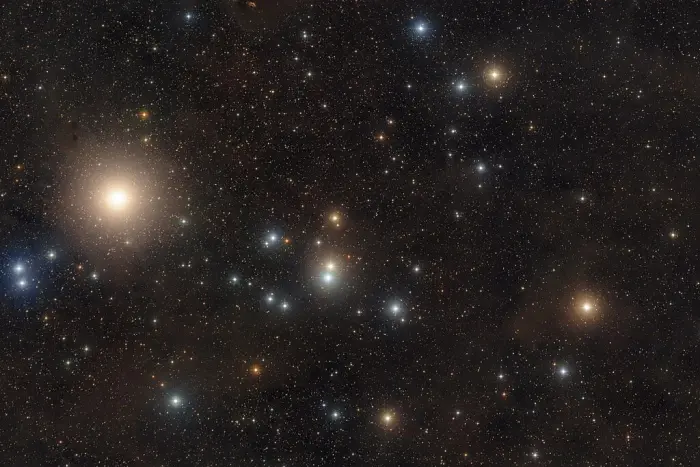
Wide-field view of the Hyades star cluster created from images forming part of the Digitized Sky Survey 2. Image credit: NOIRLab/NSF/AURA/Digitized Sky Survey 2 (CC BY 4.0)
Stars
The Hyades stars are young but evolved. The cluster has very few stars with exceptionally high or low mass and its main sequence turn-off is about 2.3 solar masses. This means that the heavier stars in the cluster have already evolved into giants, subgiants and white dwarfs.
Ten of the Hyades stars are fourth magnitude or brighter. These and other stars are visible to the unaided eye in good conditions.
The cluster has been found to show evidence of mass segregation. Its central region (2 parsecs or 6.5 light-years) contains only stars with a mass of at least 1 solar mass. The less massive stars are mostly found in the cluster’s halo.
Astronomers have detected 8 white dwarfs in the core of the cluster. These are stellar remnants of the more massive B-type stars that have already reached the end of their evolutionary cycle due to their higher mass (around 3 M☉).
Several Hyades stars have been discovered to host extrasolar planets. Ain (Epsilon Tauri) has an orbiting superjovian planet, discovered in 2007. The orange dwarf HD 285507 hosts a hot Jupiter, and the red dwarf K2-25 hosts a hot Neptune. In 2024, a young mini-Neptune was discovered orbiting the red dwarf TOI 4364.
The orange dwarf K2-136 is home to a system of at least three planets, discovered in 2017. The innermost planet is the first Earth-sized planet discovered in an open cluster.
Most open clusters dissolve before they reach a billion years in age. The Hyades group is expected to lose members and mass over the next few hundred million years until the cluster is reduced to about a dozen star systems. These will eventually dissipate, too.
Of the cluster’s several hundred stars, about 15 are visible to the unaided eye in good viewing conditions. Binoculars and small telescopes will reveal several dozen members.
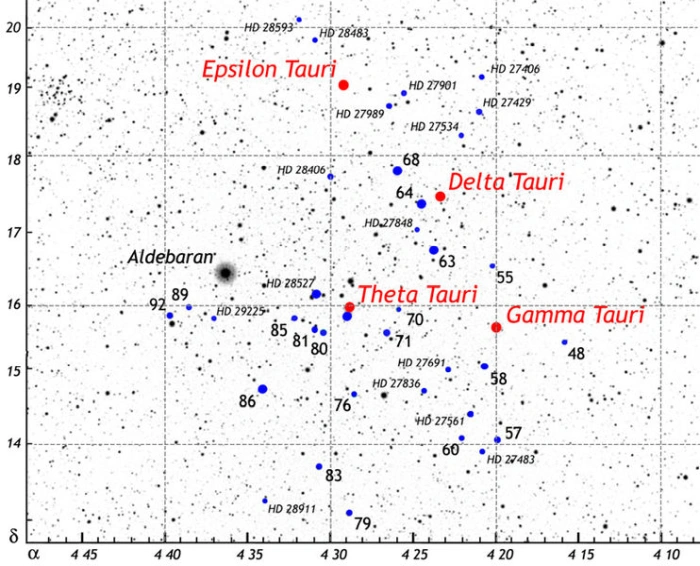
This map represents prominent stars in the core of the Hyades Cluster. Filled red circles refer to red giant stars. Filled blue circles refer to A, F, and G-type stars. The four Hyades giants are labeled with their Bayer designations (e.g., Epsilon Tauri). Arabic numerals provide Flamsteed designations (e.g., 68 Tauri). Small italics provide designations from the Henry Draper catalog (e.g., HD 28406). The vertical scale indicates declination; the horizontal scale indicates right ascension, measured in hours and minutes. Not all stars in the field of view belong to the Hyades Cluster. Membership determinations were made on the basis of Table 2 in Perryman et al., “The Hyades Cluster: distance, structure, dynamics, and age” (Astronomy and Astrophysics 331, 81-120, 1998). On this map, the only non-member star that carries a label is the most prominent one, Aldebaran. All other non-member stars are left unmarked. Image credit: Thuvan Dihn (CC BY-SA 3.0)
Brightest stars
The brightest Hyades stars – Prima Hyadum (Gamma Tauri), Secunda Hyadum (Delta1 Tauri), Ain (Epsilon Tauri), and Chamukuy (Theta2 Tauri) form a “V” shaped asterism with Aldebaran, the brightest star in Taurus. The asterism outlines the head of the celestial Bull.
Even though it appears in the same line of sight, Aldebaran lies much closer to us – 65.3 light-years away – and is not a member of the Hyades. Both the giant star and the cluster can be found by following the line of Orion’s Belt to the northwest.
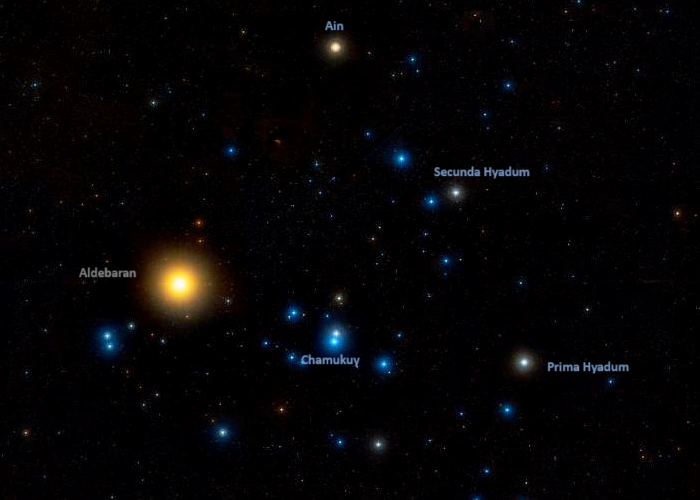
Brightest stars in the Hyades cluster, image credit: ESO/Digitized Sky Survey 2 (CC BY 4.0)
Chamukuy (Theta2 Tauri)
Chamukuy (Theta2 Tauri) is a white giant of the spectral type A7 III. It is the brightest member of the Hyades cluster. The evolved star is classified as a Delta Scuti variable. Its brightness varies from magnitude 3.35 to 3.42 due to pulsations.
Chamukuy lies approximately 157 light-years away. It has a mass of 2.86 solar masses and a radius 4.4 times that of the Sun. With an effective temperature of 7,800 K, it shines with 59 solar luminosities. It spins at 68.4 km/s.
Chamukuy has a close companion, a 6th magnitude star at a separation of at least 2 astronomical units. The two stars take 141 days to complete an orbit. The companion has a mass 2.16 times that of the Sun and a radius of 2.7 solar radii. With a surface temperature of 7,800 K, it is 21 times more luminous than the Sun. It has a projected rotational velocity of 113 km/s. The star is believed to be 650 million years old.
Chamukuy forms a wide binary system with Theta1 Tauri. The components orbit around a common centre of mass with a period of 5,997 days.
The name Chamukuy comes from the Yucatec Maya language and denotes a small bird.
Ain (Epsilon Tauri)
Ain (Epsilon Tauri) is the second brightest star in the Hyades. It has an apparent magnitude of 3.53. It is a single star classified as an orange giant of the spectral type K0III. It lies 146 light-years away.
In 2007, a team of astronomers discovered a massive exoplanet orbiting Ain. The planet, Epsilon Tauri b, is formally named Amateru. It was the first extrasolar planet discovered in an open star cluster.
Ain has 2.458 times the Sun’s mass and a radius of 12.46 solar radii. It is 79.4 times more luminous than the Sun, with a surface temperature of 4,880 K. It has an estimated age of around 600 million years. With a rotational velocity of 3 km/s, it takes 141.1 days to complete a spin.
Traditionally known as Oculus Boreus, Ain marks the Bull’s northern eye, while the bright Aldebaran marks the southern. The name Ain is Arabic for “eye.”
Prima Hyadum (Gamma Tauri)
Prima Hyadum (Gamma Tauri) is a yellow giant with the spectral type G8III. It shines at magnitude 3.654 from a distance of 154 light-years. It is the star that marks the tip of the V. Its name means “the first of the Hyades” in Latin. The star has an estimated age of 430 – 530 million years. It may be part of a double or triple star system.
Prima Hyadum has 2.70 times the Sun’s mass and a radius 13.4 times that of the Sun. It is 85 times more luminous than the Sun, with a surface temperature of 4,844 K. With a projected rotational velocity of 4 km/s, it takes around 253 days to complete a rotation.
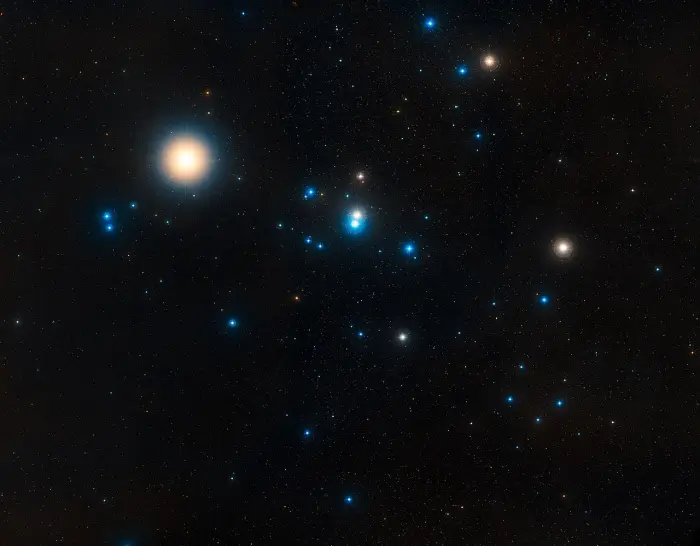
This image shows the Hyades star cluster, the nearest cluster to us. The Hyades cluster is very well studied due to its location, but early searches for planets have produced only one. A study led by Jay Farihi of the University of Cambridge, UK, has now found the atmospheres of two burnt-out stars in this cluster — known as white dwarfs — to be “polluted” by rocky debris circling the star. Seeing evidence of asteroids points to the possibility of Earth-sized planets in the same system, as asteroids are the building blocks of major planets. Planet-forming processes are inefficient, and spawn many times more small bodies than large bodies — but once rocky embryos the size of asteroids are built, planets are sure to follow. Image credit: NASA, ESA, and STScI (CC BY-SA 4.0)
Secunda Hyadum (Delta1 Tauri)
Delta1 Tauri is a multiple star located 156 light-years away. It has a combined apparent visual magnitude of 3.772.
The primary component, Delta1 Tauri Aa, is a yellow giant of the spectral type G9.5 III CN0.5. It has a mass 2.8 times that of the Sun and is 69 times more luminous than the Sun. It has expanded to a size of 11.4 solar radii and has an effective temperature of 5,000 K. The star has an estimated age of 620 million years.
Secunda Hyadum has a spectroscopic companion, Delta1 Tauri Ab, with a mass of 1.28 solar masses. The two stars are locked in a 529.8-day orbit.
A third component, Delta1 Tauri B, is separated by 111.8 arcseconds from the main pair. It has an apparent magnitude of 13.21.
Theta1 Tauri
Theta1 Tauri is a yellow giant with the stellar classification G9 III Fe-0.5. It shines at magnitude 3.84 from a distance of around 152 light years. It is younger than Chamukuy (Theta1 Tauri), with an estimated age of 510 million years.
The star has a mass of 2.67 solar masses and a radius of 9.42 solar radii. With an effective temperature of 4,940 K, it shines with 47.7 solar luminosities. It is a slow spinner, with a projected rotational velocity of 1.40 km/s.
The companion, Theta Tauri Bb, is a 7th magnitude star with a mass of 1.31 solar masses. The two stars have an orbital period of 16.26 years.
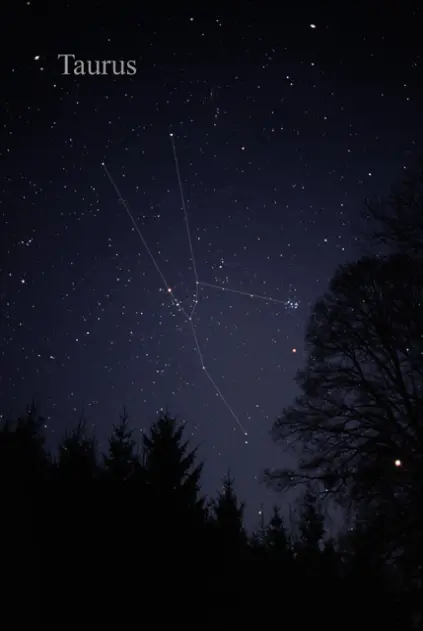
Taurus constellation, image credit: Till Credner (CC BY-SA 3.0)
Kappa Tauri
Kappa Tauri is a binary star composed of two A-type stars. The system lies 154 light-years away and shines at magnitude 4.22. Both stars are very fast spinners and much hotter and more luminous than the Sun.
A binary system composed of two 9th magnitude stars appears between the two brighter stars. The fainter components are catalogued as Kappa Tauri C and D. Two 12th magnitude stars appear in the same line of sight and are catalogued as Kappa Tauri E and F.
The fainter stars are only visual companions to the Kappa Tauri system. They lie much farther away and are not members of the Hyades cluster.
90 Tauri
90 Tauri is a white, A-type main sequence star that shines at magnitude 4.27 from a distance of 144 light-years. It has an orange K4V-type companion with an orbital period of at least 84 years.
The primary star has 2.09 times the Sun’s mass and a radius 2.8 times the Sun’s. It spins at 89 km/s and is orbited by a debris disk.
Upsilon Tauri
Upsilon Tauri is an A-type main sequence star located 154 light-years away. It has an apparent magnitude of 4.28 – 4.31 and is classified as a Delta Scuti variable. The young pulsating star has a mass of 1.55 solar masses and a radius 1.803 times that of the Sun. With a surface temperature of 7,398 K, it is 32.5 times more luminous than the Sun. It has an estimated age of 827 million years.
Upsilon Tauri is an exceptionally fast spinner. With a projected rotational velocity of 243 km/s, it takes only 0.415 days to complete a rotation. As a result, it has an oblate shape. It is flattened at the poles and has an equatorial bulge.
Delta2 Tauri
Delta2 Tauri is an A-type main sequence star located 161 light-years from Earth. It has an apparent magnitude of 4.80. It is an X-ray source, indicating that it may have a companion.
The star has a mass of 1.79 solar masses and a radius of 1.8 solar radii. With a surface temperature of 7,997 K, it is 27 times more luminous than the Sun. It has an estimated age of 449 million years.
71 Tauri
71 Tauri is another fast-spinning Delta Scuti variable. It is a yellow-white dwarf of the spectral type F0 V. It shines at magnitude 4.48 from a distance of 146 light-years.
The star spins at 192 km/s, taking 14.2 days to complete a rotation. It has a mass of 1.94 solar masses, a radius of 3.34 solar radii, and an effective temperature of 7,543 K. It is estimated to be 966 million years old. The star is the second brightest X-ray source in the cluster.
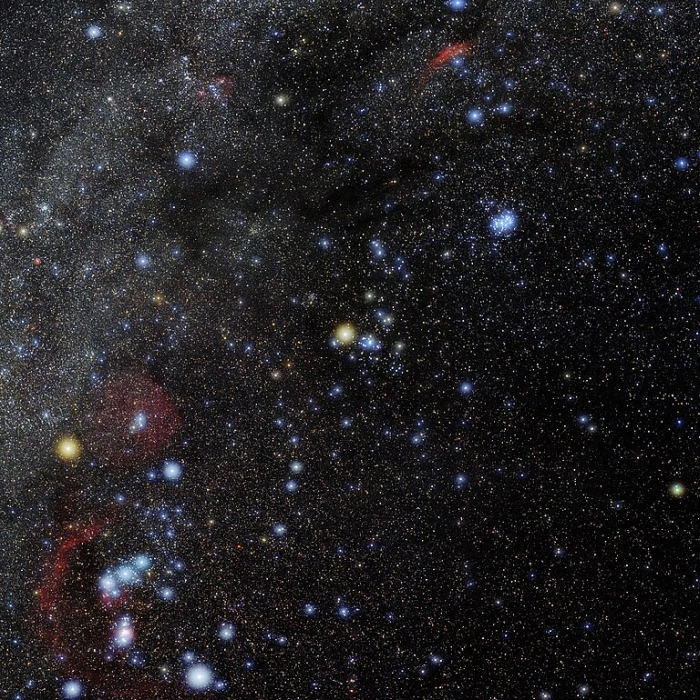
Orion constellation, the Hyades and the Pleiades. Photo of the constellation Taurus produced by NOIRLab in collaboration with Eckhard Slawik, a German astrophotographer. Credit: E. Slawik/NOIRLab/NSF/AURA/M. Zamani (CC BY 4.0)
Facts
The Hyades cluster was catalogued by the Italian astronomer Giovanni Batista Hodierna in 1654 and by the British astronomer Philibert Jacques Melotte in 1915. However, these astronomers did not discover it. The cluster has been known to different cultures since antiquity, and even prehistoric times. Unlike Praesepe and the Pleiades, which are more distant, the Hyades cluster was not included in Charles Messier’s 1781 catalogue of deep sky objects.
The Hyades is receding from us at 42 km/s. The cluster has a similar proper motion, age and metallicity as other groups of stars in the Sun’s neighbourhood. The Beehive Cluster, also known as Praesepe or Messier 44, is one of these stellar groups.
Praesepe is an open cluster located in the constellation Cancer and one of the more populated nearby clusters. It lies at an approximate distance of 610 light years from Earth. The trajectories of the Hyades and Praesepe clusters can be traced back to the same region, which suggests that the two share a common origin.
The Hyades moving group (Hyades Stream) is another stellar association that shares a similar trajectory. This is a large group of scattered stars that may have once formed a much more massive cluster, the Hyades Supercluster. However, this idea has been disputed because about 85% of the stars in the moving group have been found to have a different age and metallicity than the Hyades.
Even though the Hyades cluster appears relatively close to the Pleiades in the sky, the two clusters are unrelated. Named after Pleione, the mythical mother of the Pleiades sisters in Greek mythology, the Pleiades cluster (Messier 45) is much younger than the Hyades, with an estimated age of 75 – 150 million years.
The Hyades and the Pleiades form the Golden Gate of the Ecliptic, an asterism that marks a virtual gate on either side of the apparent path of the Sun, Moon and the solar system planets across the sky.
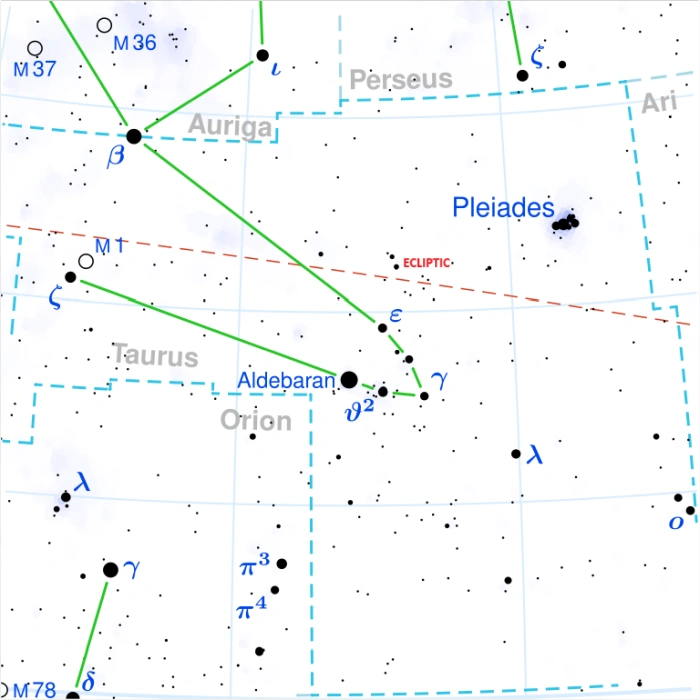
Golden Gate of the Ecliptic, image credit: Torsten Bronger (CC BY-SA 3.0)
Mythology
The Hyades star cluster is named after the Hyades (pronunciation: /ˈhaɪ.ədiːz/), the daughters of Atlas, the Titan who held up the celestial spheres, and Aethra, one of the Oceanids in Greek mythology. They were half-sisters to the Hesperides and the Pleiades.
The name Hyades means “the rainy ones.” In some versions of the myth, the sisters were the tutors of the god Dionysus.
In the myth, the nymphs were transformed into a star cluster by Zeus after the passing of their brother, Hyas, who met his end in a hunting accident. Depending on the source, the Boeotian archer was hunting either a wild boar or a lion. The sisters are said to be forever crying for Hyas.
The cluster was later associated with rain. In England, it was known as the April Rainers. The Greeks believed that the cluster’s heliacal rising and setting marked the rainy seasons.
The number of sisters varies from three to 15 in various myths. Their names also vary from source to source and include Aesyle, Ambrosia, Cleeia, Coronis, Eudora, Pedile, Phaeote, Phyto and Polyxo.
The Hyades appear in many classical works, including those of Ovid, Pliny, Horace, Hyginus, Hesiod and Homer. In the Iliad, the cluster is represented on Achilles’ shield, along with the nearby Pleiades cluster and the constellations Orion and Ursa Major.
Location
The Hyades cluster is very easy to find because it lies in a region full of bright stars and prominent asterisms. The bright cluster appears in the area between the hourglass figure of Orion (the Hunter) and the Pleiades in Taurus. It can be found by following the line formed by the three stars of Orion’s Belt – Alnitak, Alnilam, and Mintaka – to the northwest. The line leads towards Aldebaran, the brightest star in Taurus, and the cluster lies in the same field of view.
At declination +16-17°, the Hyades cluster is visible from virtually anywhere on Earth for at least part of the year. The best time of the year to see the Hyades and other deep sky objects in Taurus is during the month of January, when the constellation is higher above the horizon in the early evening. From the northern hemisphere, the cluster is visible throughout the autumn, winter and spring months.
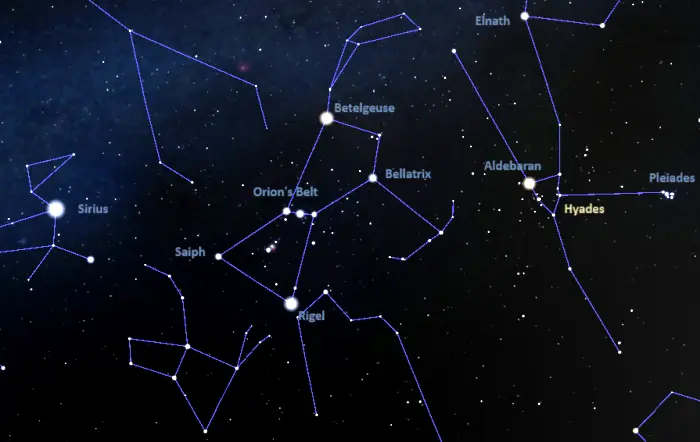
The location of the Hyades, image: Stellarium
Hyades – Caldwell 41
| Constellation | Taurus |
| Object type | Open cluster |
| Right ascension | 4h 29m 47.3s |
| Declination | +16° 56′ 53′′ |
| Apparent magnitude | 0.5 |
| Apparent size | 330’ |
| Distance | 153 light-years (47 parsecs) |
| Core radius | 8.8 light-years (2.7 parsecs) |
| Tidal radius | 33 light-years (10 parsecs) |
| Mass | 400 M☉ |
| Age | 625 million years |
| Names and designations | Hyades, Caldwell 41 (C41), Collinder 50 (Cr50), Melote 25 (Mel 25), C 0424+157, OCl 456.0, Theia 1004 |